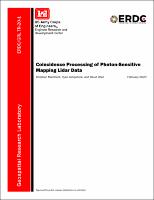Please use this identifier to cite or link to this item:
https://hdl.handle.net/11681/35599Full metadata record
| DC Field | Value | Language |
|---|---|---|
| dc.contributor.author | Marchant, Christian C. | - |
| dc.contributor.author | Kirkpatrick, Ryan W. | - |
| dc.contributor.author | Ober, David B. | - |
| dc.date.accessioned | 2020-02-19T20:19:42Z | - |
| dc.date.available | 2020-02-19T20:19:42Z | - |
| dc.date.issued | 2020-02 | - |
| dc.identifier.govdoc | ERDC/GRL TR-20-1 | - |
| dc.identifier.uri | https://hdl.handle.net/11681/35599 | - |
| dc.identifier.uri | http://dx.doi.org/10.21079/11681/35599 | - |
| dc.description | Technical Report | - |
| dc.description.abstract | Photon-sensitive mapping lidar systems are able to image at greater collection area rates and ranges than linear-mode systems. However, these systems also experience greater noise levels due to shot noise, image blur, and dark current, which must be filtered out before the imagery can be exploited. Described in this report is a synthetic test data set of imagery from a notional airborne Geiger-mode lidar. Also described is the Bridge Sign algorithm, which uses a least-squares technique for noise filtering. The algorithm’s performance was validated using synthetic test imagery of both a toy scene and of a realistic scene, which were generated using the parameters of a notional airborne Geiger-mode system. Analysis of the results shows the technique effectively removes noise and preserves fine details with good fidelity. | en_US |
| dc.description.sponsorship | United States. Army. Corps of Engineers. | en_US |
| dc.description.tableofcontents | Abstract ................................ ................................ ................................ ................................ .......................... ii Figures and Tables ................................ ................................ ................................ ................................ ........ iv Preface ................................ ................................ ................................ ................................ ............................. v 1 Introduction ................................ ................................ ................................ ................................ ............ 1 1.1 Background ................................ ................................ ................................ .................... 1 1.2 Objective ................................ ................................ ................................ ........................ 2 1.3 Approach ................................ ................................ ................................ ........................ 3 2 Coincidence Processing Approach ................................ ................................ ................................ ... 4 3 Validation Methodology ................................ ................................ ................................ ....................... 6 3.1 Artificial scene ................................ ................................ ................................ ............... 7 3.2 Real scene ................................ ................................ ................................ ................... 10 3.3 L1 generation process ................................ ................................ ................................ . 10 3.4 Realism of synthetic L L1 data ................................ ................................ ...................... 12 4 Coincidence Processing Steps ................................ ................................ ................................ ......... 14 4.1 Rasterization ................................ ................................ ................................ ................ 14 4.2 LeastLeast-squares filtering ................................ ................................ ................................ . 15 4.3 Surface finding ................................ ................................ ................................ ............ 16 5 Discussion ................................ ................................ ................................ ................................ ............ 18 6 Conclusion ................................ ................................ ................................ ................................ ............ 19 References ................................ ................................ ................................ ................................ ................... 20 Acronyms ................................ ................................ ................................ ................................ ...................... 22 Report Documentation Page | - |
| dc.format.extent | 31 pages / 1.568 Mb | - |
| dc.format.medium | PDF/A | - |
| dc.language.iso | en_US | en_US |
| dc.publisher | Geospatial Research Laboratory (U.S.) | en_US |
| dc.publisher | Engineer Research and Development Center (U.S.) | - |
| dc.relation.ispartofseries | Technical Report (Engineer Research and Development Center (U.S.)) ; no. ERDC/GRL TR-20-1 | - |
| dc.rights | Approved for Public Release; Distribution is Unlimited | - |
| dc.source | This Digital Resource was created in Microsoft Word and Adobe Acrobat | - |
| dc.subject | Optics | en_US |
| dc.subject | Algorithms | en_US |
| dc.subject | Photonics | en_US |
| dc.subject | Photon detectors | en_US |
| dc.subject | Light | en_US |
| dc.subject | Electronic data processing | en_US |
| dc.subject | Lasers | en_US |
| dc.subject | Lidar | en_US |
| dc.subject | Mapping | en_US |
| dc.subject | Topography | en_US |
| dc.subject | Optical radar | en_US |
| dc.title | Coincidence processing of photon-sensitive mapping lidar data | en_US |
| dc.type | Report | en_US |
| Appears in Collections: | Technical Report | |
Files in This Item:
| File | Description | Size | Format | |
|---|---|---|---|---|
| ERDC-GRL TR-20-1.pdf | 1.61 MB | Adobe PDF |  View/Open |